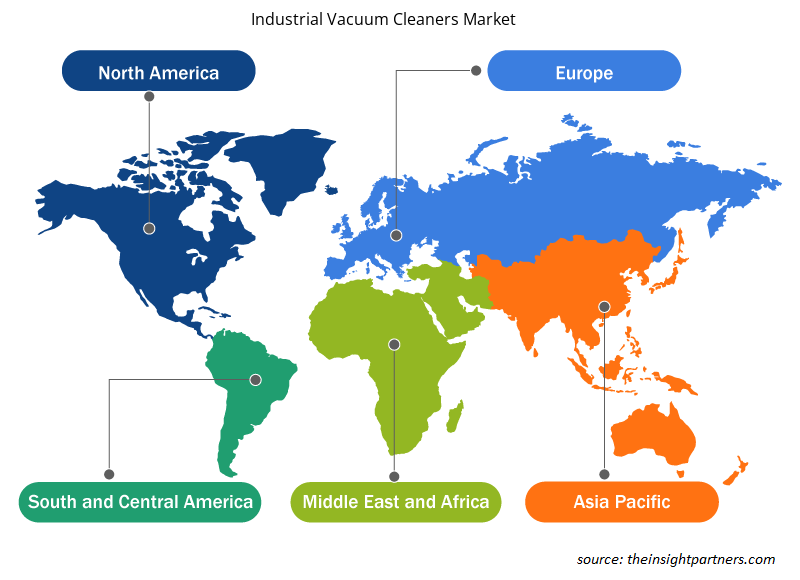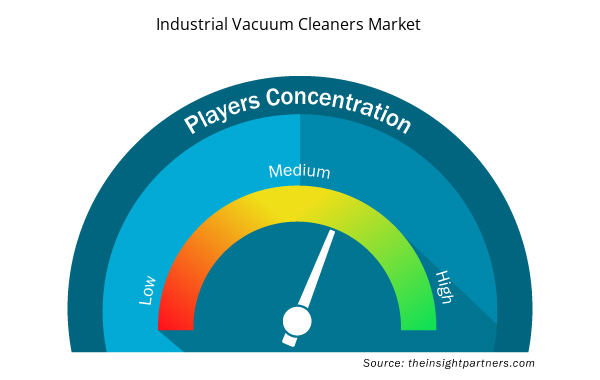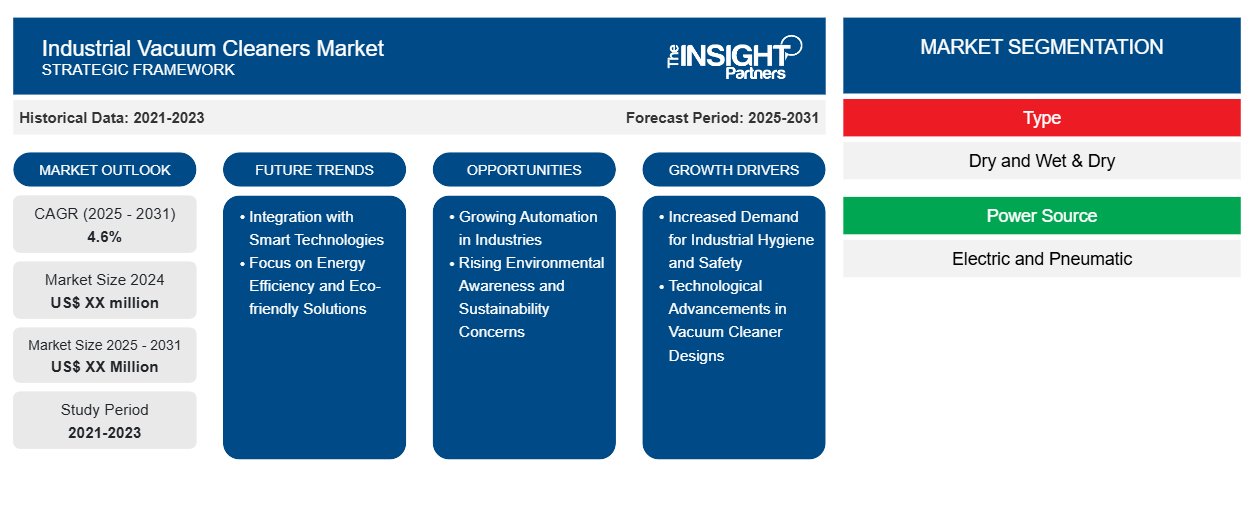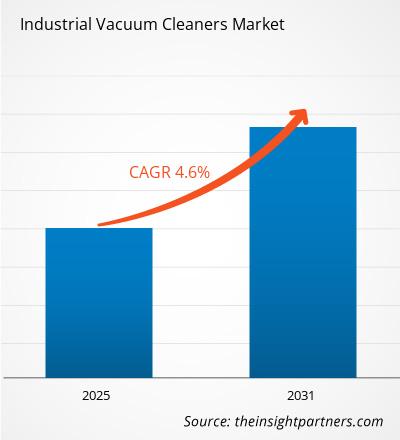Se espera que el mercado de aspiradoras industriales registre una CAGR del 4,6 % entre 2023 y 2031, con un tamaño de mercado que se expandirá de US$ XX millones en 2023 a US$ XX millones en 2031.
El informe está segmentado por tipo (seco y húmedo y seco); fuente de energía (eléctrica y neumática); industria (alimentos y bebidas, productos farmacéuticos, metalurgia, construcción y edificación, otros). El análisis global se desglosa aún más a nivel regional y por países principales. El informe ofrece el valor en USD para el análisis y los segmentos anteriores.
Propósito del Informe
El informe sobre el mercado de aspiradoras industriales de The Insight Partners tiene como objetivo describir el panorama actual y el crecimiento futuro, los principales factores impulsores, los desafíos y las oportunidades. Esto proporcionará información a diversas partes interesadas del negocio, como:
- Proveedores/fabricantes de tecnología: Para comprender la dinámica cambiante del mercado y conocer las oportunidades potenciales de crecimiento, lo que les permitirá tomar decisiones estratégicas informadas.
- Inversionistas: Realizar un análisis exhaustivo de tendencias sobre la tasa de crecimiento del mercado, las proyecciones financieras del mercado y las oportunidades que existen en toda la cadena de valor.
- Órganos reguladores: Regular las políticas y vigilar las actividades del mercado con el objetivo de minimizar los abusos, preservar la confianza de los inversores y defender la integridad y la estabilidad del mercado.
Segmentación del mercado de aspiradoras industriales
Tipo
- Seco y húmedo y seco
Fuente de poder
- Eléctrico y neumático
Industria
- Alimentos y bebidas
- Productos farmacéuticos
- Trabajo de metales
- Construcción y edificación
- Otros
Geografía
- América del norte
- Europa
- Asia-Pacífico
- América del Sur y Central
- Oriente Medio y África
Geografía
- América del norte
- Europa
- Asia-Pacífico
- América del Sur y Central
- Oriente Medio y África
Personalice este informe según sus necesidades
Obtendrá personalización en cualquier informe, sin cargo, incluidas partes de este informe o análisis a nivel de país, paquete de datos de Excel, así como también grandes ofertas y descuentos para empresas emergentes y universidades.
- Obtenga las principales tendencias clave del mercado de este informe.Esta muestra GRATUITA incluirá análisis de datos, desde tendencias del mercado hasta estimaciones y pronósticos.
Factores impulsores del crecimiento del mercado de las aspiradoras industriales
- Mayor demanda de higiene y seguridad industrial: La higiene industrial requiere mantener la limpieza en los entornos industriales. Esto aumenta los niveles de seguridad y mejora la eficiencia operativa en el lugar de trabajo. Las aspiradoras industriales ayudan a reducir el polvo y los materiales peligrosos que podrían poner en peligro a las personas, causar problemas respiratorios y provocar accidentes en las empresas. Las normas laborales internacionales y las estrictas regulaciones en materia de seguridad en el lugar de trabajo, como la OSHA (Administración de Seguridad y Salud Ocupacional) establecida en los EE. UU., también están impulsando la demanda de aspiradoras industriales. Las altas exigencias en materia de limpieza se aplican tanto a la industria alimentaria como a la farmacéutica, lo que hace que el mercado crezca aún más debido a las estrictas regulaciones.
- Avances tecnológicos en el diseño de aspiradoras: características avanzadas como la instalación de filtros HEPA para una limpieza eficaz, sistemas de limpieza automáticos, capacidad inalámbrica e integración con IoT (Internet de las cosas) han aumentado aún más la tasa de adopción de aspiradoras industriales. Estos factores han elevado la eficiencia y la comodidad junto con el rendimiento de limpieza, lo que ha mejorado indirectamente la productividad de los procesos industriales.
Tendencias futuras del mercado de aspiradoras industriales
- Integración con tecnologías inteligentes: el uso cada vez mayor de IoT en aplicaciones industriales ofrece un enorme mercado para que los fabricantes de aspiradoras industriales integren tecnología inteligente en sus productos. La integración de sensores y conectividad en una aspiradora permite la monitorización en tiempo real, el mantenimiento predictivo y los ajustes automáticos para mejorar el rendimiento de la aspiradora. Además, las aspiradoras industriales inteligentes se pueden conectar a un sistema de limpieza automatizado más completo para ofrecer una experiencia de limpieza eficiente y sin problemas a las empresas.
- Enfoque en la eficiencia energética y soluciones ecológicas: otra tendencia destacada en el mercado de las aspiradoras industriales es el énfasis en las soluciones de limpieza ecológicas y energéticamente eficientes. Con una creciente conciencia sobre la sostenibilidad y las normativas medioambientales, los fabricantes están diseñando aspiradoras que consumen menos energía y, al mismo tiempo, ofrecen un potente rendimiento de succión y limpieza. Además, existe un mayor enfoque en la reducción del impacto medioambiental de las aspiradoras mediante el uso de materiales reciclables, motores energéticamente eficientes y operaciones silenciosas. Estas innovaciones ecológicas no solo ayudan a las empresas a reducir su huella de carbono, sino que también se alinean con las tendencias mundiales de sostenibilidad y las iniciativas de ahorro energético.
Oportunidades de mercado para aspiradoras industriales
- Aumento de la automatización en las industrias: con un mayor énfasis en la automatización en las industrias, las aspiradoras industriales se están convirtiendo en parte integral de la automatización general de los procesos de limpieza. Los sistemas de aspiración industriales automatizados funcionan de forma continua y requieren una intervención mínima del operador, lo que reduce los gastos operativos y la mano de obra. Los sistemas de aspiración que pueden interactuar con sistemas automatizados tienen una mayor demanda a medida que las industrias buscan una mayor automatización en sus procesos.
- La creciente conciencia ambiental y las preocupaciones por la sostenibilidad: las preocupaciones por el medio ambiente están impulsando a las empresas a adoptar enfoques más ecológicos y limpios en materia de saneamiento mediante una limpieza más sostenible. El ahorro de energía, la reducción de residuos y un aire más limpio hacen que las aspiradoras industriales sean muy solicitadas. Muchas aspiradoras industriales también están diseñadas para capturar contaminantes que, de otro modo, irían a parar a la atmósfera, lo que respalda los esfuerzos por lograr una operación industrial más sostenible.
Perspectivas regionales del mercado de aspiradoras industriales
Los analistas de Insight Partners explicaron en detalle las tendencias y los factores regionales que influyen en el mercado de aspiradoras industriales durante el período de pronóstico. Esta sección también analiza los segmentos y la geografía del mercado de aspiradoras industriales en América del Norte, Europa, Asia Pacífico, Oriente Medio y África, y América del Sur y Central.

- Obtenga datos regionales específicos para el mercado de aspiradoras industriales
Alcance del informe de mercado de aspiradoras industriales
| Atributo del informe | Detalles |
|---|---|
| Tamaño del mercado en 2023 | XX millones de dólares estadounidenses |
| Tamaño del mercado en 2031 | US$ XX millones |
| CAGR global (2023 - 2031) | 4,6% |
| Datos históricos | 2021-2022 |
| Período de pronóstico | 2024-2031 |
| Segmentos cubiertos | Por tipo
|
| Regiones y países cubiertos | América del norte
|
| Líderes del mercado y perfiles de empresas clave |
|
Densidad de actores del mercado de aspiradoras industriales: comprensión de su impacto en la dinámica empresarial
El mercado de aspiradoras industriales está creciendo rápidamente, impulsado por la creciente demanda de los usuarios finales debido a factores como la evolución de las preferencias de los consumidores, los avances tecnológicos y una mayor conciencia de los beneficios del producto. A medida que aumenta la demanda, las empresas amplían sus ofertas, innovan para satisfacer las necesidades de los consumidores y aprovechan las tendencias emergentes, lo que impulsa aún más el crecimiento del mercado.
La densidad de actores del mercado se refiere a la distribución de las empresas o firmas que operan dentro de un mercado o industria en particular. Indica cuántos competidores (actores del mercado) están presentes en un espacio de mercado determinado en relación con su tamaño o valor total de mercado.
Las principales empresas que operan en el mercado de aspiradoras industriales son:
- Compañía de vacío americana
- SPA Comac
- Diversey Inc.
- Eureka Forbes
- Corporación Exair
Descargo de responsabilidad : Las empresas enumeradas anteriormente no están clasificadas en ningún orden particular.

- Obtenga una descripción general de los principales actores clave del mercado de aspiradoras industriales
Puntos de venta clave
- Cobertura integral: el informe cubre exhaustivamente el análisis de productos, servicios, tipos y usuarios finales del mercado de aspiradoras industriales, proporcionando un panorama holístico.
- Análisis de expertos: el informe se compila sobre la base de un profundo conocimiento de expertos y analistas de la industria.
- Información actualizada: El informe asegura relevancia comercial debido a su cobertura de información reciente y tendencias de datos.
- Opciones de personalización: este informe se puede personalizar para satisfacer los requisitos específicos del cliente y adaptarse adecuadamente a las estrategias comerciales.
Por lo tanto, el informe de investigación sobre el mercado de aspiradoras industriales puede ayudar a abrir camino para descifrar y comprender el escenario de la industria y las perspectivas de crecimiento. Si bien puede haber algunas preocupaciones válidas, los beneficios generales de este informe tienden a superar las desventajas.
- Análisis histórico (2 años), año base, pronóstico (7 años) con CAGR
- Análisis PEST y FODA
- Tamaño del mercado Valor/volumen: global, regional, nacional
- Industria y panorama competitivo
- Conjunto de datos de Excel


- USB Device Market
- Environmental Consulting Service Market
- Surety Market
- Aerospace Forging Market
- Mice Model Market
- Arterial Blood Gas Kits Market
- Malaria Treatment Market
- Quantitative Structure-Activity Relationship (QSAR) Market
- Portable Power Station Market
- Integrated Platform Management System Market

Report Coverage
Revenue forecast, Company Analysis, Industry landscape, Growth factors, and Trends

Segment Covered
This text is related
to segments covered.

Regional Scope
North America, Europe, Asia Pacific, Middle East & Africa, South & Central America

Country Scope
This text is related
to country scope.
Preguntas frecuentes
Some of the customization options available based on the request are an additional 3-5 company profiles and country-specific analysis of 3-5 countries of your choice. Customizations are to be requested/discussed before making final order confirmation as our team would review the same and check the feasibility
The report can be delivered in PDF/PPT format; we can also share excel dataset based on the request
Integration with Smart Technologies is anticipated to play a significant role in the global industrial vacuum cleaners market in the coming years
The major factors driving the industrial vacuum cleaners market are:
1. Increased Demand for Industrial Hygiene and Safety
2. Technological Advancements in Vacuum Cleaner Designs
The Industrial Vacuum Cleaners Market is estimated to witness a CAGR of 4.6% from 2023 to 2031
Trends and growth analysis reports related to Electronics and Semiconductor : READ MORE..
1. American Vacuum Company
2. Comac S.P.A.
3. Diversey Inc.
4. Eureka Forbes
5. Exair Corporation
6. Kaercher
7. Nederman Holding AB
8. Numatic International Ltd.
9. Suiden Co., Ltd.
10. Tennant Company
The Insight Partners performs research in 4 major stages: Data Collection & Secondary Research, Primary Research, Data Analysis and Data Triangulation & Final Review.
- Data Collection and Secondary Research:
As a market research and consulting firm operating from a decade, we have published and advised several client across the globe. First step for any study will start with an assessment of currently available data and insights from existing reports. Further, historical and current market information is collected from Investor Presentations, Annual Reports, SEC Filings, etc., and other information related to company’s performance and market positioning are gathered from Paid Databases (Factiva, Hoovers, and Reuters) and various other publications available in public domain.
Several associations trade associates, technical forums, institutes, societies and organization are accessed to gain technical as well as market related insights through their publications such as research papers, blogs and press releases related to the studies are referred to get cues about the market. Further, white papers, journals, magazines, and other news articles published in last 3 years are scrutinized and analyzed to understand the current market trends.
- Primary Research:
The primarily interview analysis comprise of data obtained from industry participants interview and answers to survey questions gathered by in-house primary team.
For primary research, interviews are conducted with industry experts/CEOs/Marketing Managers/VPs/Subject Matter Experts from both demand and supply side to get a 360-degree view of the market. The primary team conducts several interviews based on the complexity of the markets to understand the various market trends and dynamics which makes research more credible and precise.
A typical research interview fulfils the following functions:
- Provides first-hand information on the market size, market trends, growth trends, competitive landscape, and outlook
- Validates and strengthens in-house secondary research findings
- Develops the analysis team’s expertise and market understanding
Primary research involves email interactions and telephone interviews for each market, category, segment, and sub-segment across geographies. The participants who typically take part in such a process include, but are not limited to:
- Industry participants: VPs, business development managers, market intelligence managers and national sales managers
- Outside experts: Valuation experts, research analysts and key opinion leaders specializing in the electronics and semiconductor industry.
Below is the breakup of our primary respondents by company, designation, and region:

Once we receive the confirmation from primary research sources or primary respondents, we finalize the base year market estimation and forecast the data as per the macroeconomic and microeconomic factors assessed during data collection.
- Data Analysis:
Once data is validated through both secondary as well as primary respondents, we finalize the market estimations by hypothesis formulation and factor analysis at regional and country level.
- Macro-Economic Factor Analysis:
We analyse macroeconomic indicators such the gross domestic product (GDP), increase in the demand for goods and services across industries, technological advancement, regional economic growth, governmental policies, the influence of COVID-19, PEST analysis, and other aspects. This analysis aids in setting benchmarks for various nations/regions and approximating market splits. Additionally, the general trend of the aforementioned components aid in determining the market's development possibilities.
- Country Level Data:
Various factors that are especially aligned to the country are taken into account to determine the market size for a certain area and country, including the presence of vendors, such as headquarters and offices, the country's GDP, demand patterns, and industry growth. To comprehend the market dynamics for the nation, a number of growth variables, inhibitors, application areas, and current market trends are researched. The aforementioned elements aid in determining the country's overall market's growth potential.
- Company Profile:
The “Table of Contents” is formulated by listing and analyzing more than 25 - 30 companies operating in the market ecosystem across geographies. However, we profile only 10 companies as a standard practice in our syndicate reports. These 10 companies comprise leading, emerging, and regional players. Nonetheless, our analysis is not restricted to the 10 listed companies, we also analyze other companies present in the market to develop a holistic view and understand the prevailing trends. The “Company Profiles” section in the report covers key facts, business description, products & services, financial information, SWOT analysis, and key developments. The financial information presented is extracted from the annual reports and official documents of the publicly listed companies. Upon collecting the information for the sections of respective companies, we verify them via various primary sources and then compile the data in respective company profiles. The company level information helps us in deriving the base number as well as in forecasting the market size.
- Developing Base Number:
Aggregation of sales statistics (2020-2022) and macro-economic factor, and other secondary and primary research insights are utilized to arrive at base number and related market shares for 2022. The data gaps are identified in this step and relevant market data is analyzed, collected from paid primary interviews or databases. On finalizing the base year market size, forecasts are developed on the basis of macro-economic, industry and market growth factors and company level analysis.
- Data Triangulation and Final Review:
The market findings and base year market size calculations are validated from supply as well as demand side. Demand side validations are based on macro-economic factor analysis and benchmarks for respective regions and countries. In case of supply side validations, revenues of major companies are estimated (in case not available) based on industry benchmark, approximate number of employees, product portfolio, and primary interviews revenues are gathered. Further revenue from target product/service segment is assessed to avoid overshooting of market statistics. In case of heavy deviations between supply and demand side values, all thes steps are repeated to achieve synchronization.
We follow an iterative model, wherein we share our research findings with Subject Matter Experts (SME’s) and Key Opinion Leaders (KOLs) until consensus view of the market is not formulated – this model negates any drastic deviation in the opinions of experts. Only validated and universally acceptable research findings are quoted in our reports.
We have important check points that we use to validate our research findings – which we call – data triangulation, where we validate the information, we generate from secondary sources with primary interviews and then we re-validate with our internal data bases and Subject matter experts. This comprehensive model enables us to deliver high quality, reliable data in shortest possible time.


 Obtenga una muestra gratuita de este informe
Obtenga una muestra gratuita de este informe